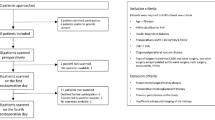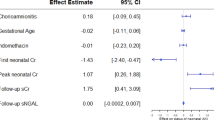Abstract
Background
Renal resistive index (RRI) and renal pulsatility index (RPI) are Doppler-based variables proposed to assess renal perfusion at the bedside in critically ill patients. This study aimed to assess the accuracy of such variables to predict acute kidney injury (AKI) in mechanically ventilated children.
Methods
Consecutive children aged <14 years underwent kidney Doppler ultrasound examination within 24 h of invasive mechanical ventilation. Renal resistive index (RRI) and renal pulsatility index (RPI) were measured. The primary outcome was severe AKI (KDIGO stage 2 or 3) on day 3.
Results
On day 3, 22 patients were classified as having AKI, of which 12 were severe. RRI could effectively predict severe AKI (area under the ROC curve [AUC] = 0.94) as well as RPI (AUC = 0.86). The optimal cut-off for RRI was 0.85 (sensitivity, 91.7%; specificity, 84.7%; PPV, 50.0%; and NPV, 98.4%). Similar results were obtained when the accuracy to predict AKI on day 5 was assessed. Significant correlations were observed between RRI and estimated glomerular filtration rate at enrollment (ρ = −0.495) and on day 3 (ρ = −0.467).
Conclusions
Renal Doppler ultrasound may be a promising tool to predict AKI in critically ill children under invasive mechanical ventilation.
Impact
-
Early recognition of acute kidney injury (AKI) is essential to promptly initiate supportive care aimed at restoring renal perfusion, which may prevent or attenuate acute tubular necrosis.
-
Renal arterial Doppler-based parameters are rapid, noninvasive, and repeatable variables that may be promising for the prediction of AKI in children.
-
To the best of our knowledge, this is the first study to evaluate the use of renal Doppler-based variables to predict AKI in critically ill children.
-
The present study found that Doppler-based variables could accurately predict the occurrence of severe AKI and were correlated with urinary output and diuretic use.
Similar content being viewed by others
Log in or create a free account to read this content
Gain free access to this article, as well as selected content from this journal and more on nature.com
or
Data availability
The data that support the findings of this study are available from the corresponding author upon reasonable request.
References
McGregor, T. L. et al. Acute kidney injury incidence in noncritically ill hospitalized children, adolescents, and young adults: a retrospective observational study. Am. J. Kidney Dis. 67, 384–390 (2016).
Kaddourah, A., Basu, R. K., Bagshaw, S. M. & Goldstein, S. L. Epidemiology of acute kidney injury in critically ill children and young adults. N. Engl. J. Med. 376, 11–20 (2016).
Selewski, D. T. & Symons, J. M. Acute kidney injury. Pediatr. Rev. 35, 30–41 (2014).
Lameire, N., Van Biesen, W. & Vanholder, R. Acute renal failure. Lancet 365, 417–430 (2005).
Kellum, J. A. et al. Kidney disease: improving global outcomes (KDIGO) acute kidney injury work group. KDIGO clinical practice guideline for acute kidney injury. Kidney Int. Suppl. 2, 1–138 (2012).
Haitsma Mulier, J. L. G. et al. Renal resistive index as an early predictor and discriminator of acute kidney injury in critically ill patients; a prospective observational cohort study. PLoS ONE 13, 1–18 (2018).
Izumi, M. et al. Differential diagnosis of prerenal azotemia from acute tubular necrosis and prediction of recovery by Doppler ultrasound. Am. J. Kidney Dis. 35, 713–719 (2000).
Advanced Life Support Group. Advanced Paediatric Life Support: A Practical Approach to Emergencies (Wiley-Blackwell, 2016).
Stevens, P. E. & Levin, A. Evaluation and Management of Chronic Kidney Disease: Synopsis of the Kidney Disease: improving global outcomes 2012 clinical practice guideline. Ann. Intern. Med. 158, 825–830 (2013).
van Dijk, M., Peters, J. W. B., van Deventer, P. & Tibboel, D. The COMFORT Behavior Scale: a tool for assessing pain and sedation in infants. Am. J. Nurs. 105, 33–36 (2005).
Rubio, A. J., de Souza, L. L., Nogueira, R. J. N., Brandão, M. B. & de Souza, T. H. Carotid Doppler ultrasonography for hemodynamic assessment in critically ill children. Pediatr. Cardiologyrdiol. 43, 382–390 (2022).
Schwartz, G. J. & Work, D. F. Measurement and estimation of GFR in children and adolescents. Clin. J. Am. Soc. Nephrol. 4, 1832–1843 (2009).
Zappitelli, M. et al. Ascertainment and epidemiology of acute kidney injury varies with definition interpretation. Clin. J. Am. Soc. Nephrol. 3, 948 LP–954 (2008).
Le Dorze, M., Bouglé, A., Deruddre, S. & Duranteau, J. Renal Doppler ultrasound: a new tool to assess renal perfusion in critical illness. Shock 37, 360–365 (2012).
Bude, R. O. & Rubin, J. M. Relationship between the resistive index and vascular compliance and resistance. Radiology 211, 411–417 (1999).
Platt, J. F., Rubin, J. M. & Ellis, J. H. Acute renal failure: possible role of duplex Doppler US in distinction between acute prerenal failure and acute tubular necrosis. Radiology 179, 419–423 (1991).
Stevens, P. E. et al. Noninvasive monitoring of renal blood flow characteristics during acute renal failure in man. Intensive Care Med. 16, 153–158 (1990).
Lerolle, N. et al. Renal failure in septic shock: predictive value of Doppler-based renal arterial resistive index. Intensive Care Med. 32, 1553–1559 (2006).
Ninet, S. et al. Doppler-based renal resistive index for prediction of renal dysfunction reversibility: a systematic review and meta-analysis. J. Crit. Care 30, 629–635 (2015).
Cvitković Kuzmić, A., Brkljačić, B., Ivanković, D. & Galešić, K. Doppler sonographic renal resistance index in healthy children. Eur. Radiol. 10, 1644–1648 (2000).
Murat, A., Akarsu, S., Ozdemir, H., Yildirim, H. & Kalender, O. Renal resistive index in healthy children. Eur. J. Radiol. 53, 67–71 (2005).
Kelly, L. K. & Seri, I. Renal developmental physiology relevance to clinical care. NeoReviews 9, e150–e161 (2008).
Fiselier, T. et al. The basal levels of active and inactive plasma renin concentration in infancy and childhood. Clin. Sci. 67, 383–387 (1984).
Zubarev, A. V. Ultrasound of renal vessels. Eur. Radiol. 11, 1902–1915 (2001).
Eibenberger, K. et al. Intrarenal Doppler ultrasonography: which vessel should be investigated? J. Ultrasound Med. 14, 451–455 (1995).
Saif, A., Soliman, N. & Abdelhamid, A. Doppler assessment of renal hemodynamic alterations in homozygous sickle cell disease and sickle beta-thalassemia. Ultrasonic Imaging 37, 258–264 (2014).
Dewitte, A. et al. Doppler resistive index to reflect regulation of renal vascular tone during sepsis and acute kidney injury. Crit. Care 16, 1–8 (2012).
Bossard, G., Bourgoin, P., Corbeau, J. J., Huntzinger, J. & Beydon, L. Early detection of postoperative acute kidney injury by Doppler renal resistive index in cardiac surgery with cardiopulmonary bypass. Br. J. Anaesth. 107, 891–898 (2011).
Meola, M., Nalesso, F., Petrucci, I., Samoni, S. & Ronco, C. Ultrasound in acute kidney disease. Contrib. Nephrol. 188, 11–20 (2016).
Acknowledgements
Thank you to Carolina Grotta Ramos Telio for her review of the manuscript. We also thank the legal guardians of the participants, attending physicians, pediatric critical care residents, and the nursing staff.
Funding
The authors declare that no funds, grants, or other support were received during the preparation of this manuscript.
Author information
Authors and Affiliations
Contributions
Conception and design: T.H.d.S.; acquisition of data: A.V.d.C., I.S.F., F.M.d.S.; T.H.d.S.; analysis and interpretation of data: A.V.d.C., I.S.F., T.H.d.S.; drafting the article: A.V.d.C., I.S.F., T.H.d.S.; revising the article critically for important intellectual content: R.J.N.N., M.B.B., and D.F.S.A.; all of the authors read and approved the manuscript.
Corresponding author
Ethics declarations
Competing interests
The authors declare no competing interests.
Ethics approval and consent to participate
This study was performed in line with the principles of the Declaration of Helsinki. Approval was granted by the UNICAMP’s Research and Ethics Committee, approval #44357421.7.0000.5404. Written informed consent was obtained from the parents.
Additional information
Publisher’s note Springer Nature remains neutral with regard to jurisdictional claims in published maps and institutional affiliations.
Rights and permissions
Springer Nature or its licensor holds exclusive rights to this article under a publishing agreement with the author(s) or other rightsholder(s); author self-archiving of the accepted manuscript version of this article is solely governed by the terms of such publishing agreement and applicable law.
About this article
Cite this article
de Carvalho, A.V., Ferraz, I.d.S., de Souza, F.M. et al. Acute kidney injury in critically ill children: predictive value of renal arterial Doppler assessment. Pediatr Res 93, 1694–1700 (2023). https://doi.org/10.1038/s41390-022-02296-1
Received:
Revised:
Accepted:
Published:
Issue date:
DOI: https://doi.org/10.1038/s41390-022-02296-1
This article is cited by
-
Acute kidney injury in children undergoing cardiac surgery: predictive value of kidney arterial Doppler-based variables
Pediatric Nephrology (2024)
-
Renal resistive index by point of care ultrasound to predict sepsis associated acute kidney injury in critically ill children
Pediatric Nephrology (2024)
-
Kidney point-of-care ultrasonography in the PICU: it is about time!
Pediatric Nephrology (2024)



